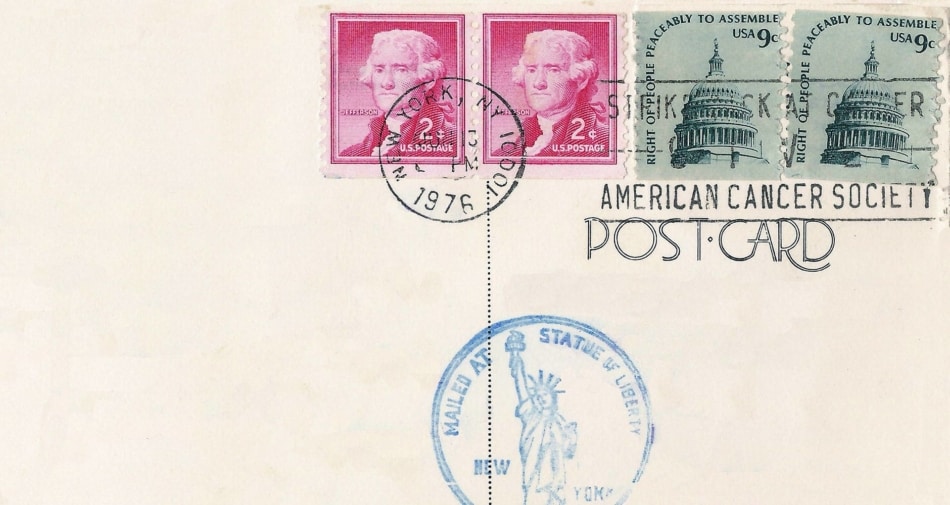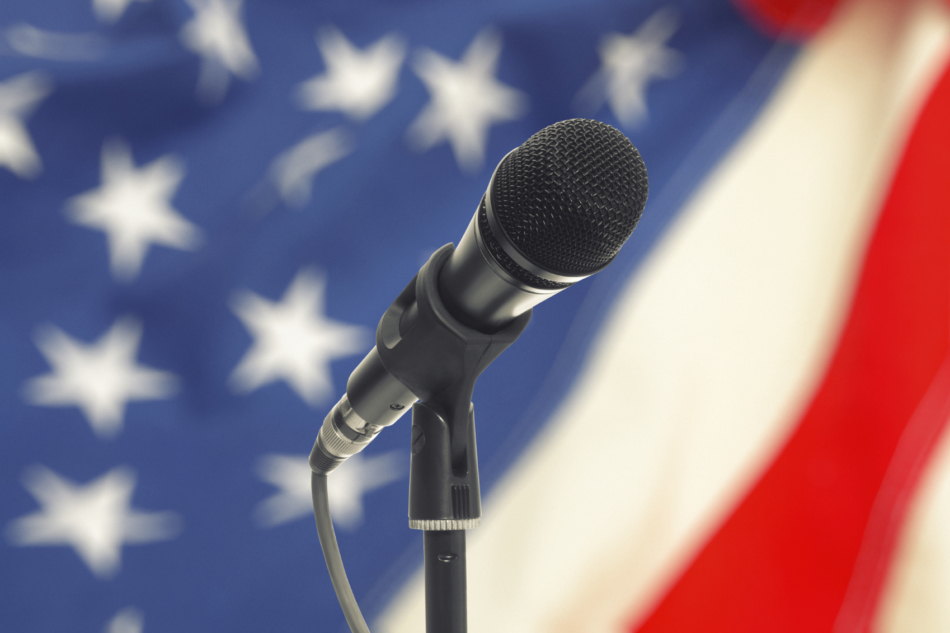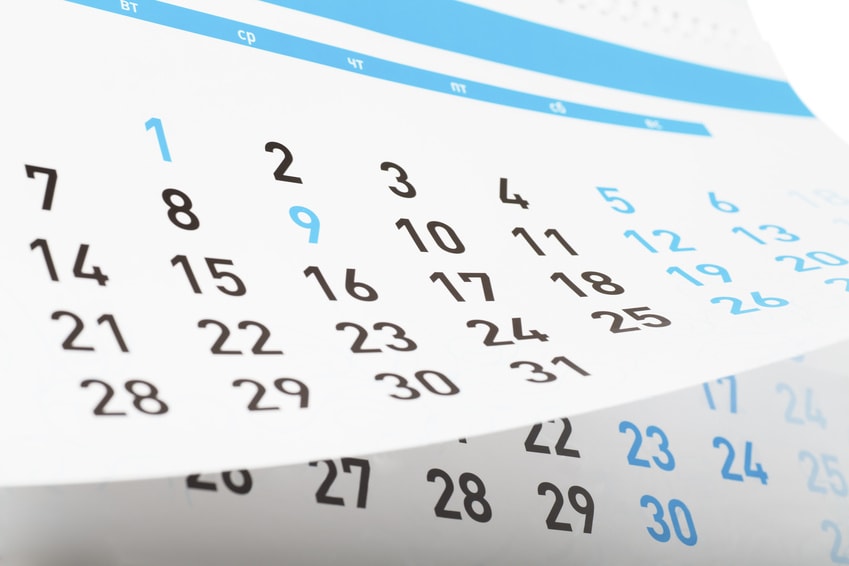While the Farmers’ Almanac is known for its weather forecasts and gardening tips, we also launch human interest crusades. These crusades or “campaigns,” as we call them, are chosen in an effort to address everyday (non-political) things that maybe have fallen victim to the “it’s always been done that way” mindset. They’re usually something we can all relate to, and things that could possibly make life easier and more enjoyable with a few simple tweaks.
Here are some of the notable campaigns we’ve done over the years:

1975 – Bring Back The Friendly Postmark
In 1973 the U.S. Postal Service decided to eliminate the name of the city or town of origin from the postmarks on mailing pieces. Substituted therefore was the legend “U.S. Postal Service” plus a state abbreviation and a three-numeral ZIP number which a trained postal clerk can interpret, but which doesn’t tell the recipient of a letter very much.
Sectional Centers of the Postal Service now handle the cancellation of mail from many post offices both small and large in the areas which they cover. Here, sophisticated machines do a swift and efficient job of handling and routing letters and of putting on postmarks – without place names, the inclusion of which would defeat the primary purpose of handling large volumes of mail at high rates of speed.
Efficient it undoubtedly is, but romantic it isn’t — “OK740” is a far cry from the “Broken Arrow, Okla.” of yore. Flipping through the morning mail and spotting the postmarks of favorite correspondents isn’t going to be possible any longer, and it was fun. But so were a lot of things on which we can now only look back with nostalgic regret.
However, we wonder if it is not possible to use the postmark of the area in which the letter is mailed — at least “Dayton, Ohio” is better than “U.S. Postal Service OH513.”
Check your mail and see how well we did with this crusade!

1987 – Our National Anthem – Oh Say, Should We Save It?
It was proposed, that these United States should forever discard what has for years been its National Anthem — “The Star Spangled Banner.”
It is that well-known, well-loved song which the band plays before the game begins, when the teams line up bare-headed and at attention as red-blooded Americans in the crowd remove hats and hold them reverently over hearts while a well-intentioned vocalist tries to cope with the high notes- and sometimes even makes it! Then, if it’s a national broadcast, the TV camera pans to Old Glory, which is preferably rippling in the breeze and millions of people who are watching get catches in their throats, tears in their eyes and goose bumps all over. It’s a feeling, an emotion, a pride. Americans can’t resist it, no matter how cynical they pretend to be.
It has been our National Anthem for so many years -it stands for something which we love and revere. So why does anybody want to change to another anthem? Well, there are all sorts of reasons. You judge how valid they are.
- The tune was written by an Englishman as a drinking song for a London social club in the early 1800s, and it might therefore be considered un-American.
- It spans twelve notes, so no matter what key you put it in, it isn’t easy to sing, and most of us are a little flat by the time we get to “the rockets’ red glare.”
- Francis Scott Key’s poem leaves something to be desired, in the minds of most critics, and furthermore the song was not adopted by Congress as the National Anthem until 1931.
The only serious contender as a replacement is “America the Beautiful.” A bill to make this change was submitted to the House of Representatives in 1985. Supporters of this action point out that these lovely lyrics were written by Katherine Lee Bates and the music by Samuel Ward, both Americans. The tune is simple arid dignified and easy to sing for either trained or untrained voices.
The poem, all four stanzas of it, are beautiful and easily remembered. With truly classic simplicity it compasses both the rural and city life of our nation, its geography, its history, its aims and ideals, and the brotherhood of its people. It is in every sense a masterpiece.
Leaving the music aside, consider the conditions under which the two poems were written. Francis Scott Key wrote his literally in the heat of battle as he watched, under a flag of truce, from the deck of a British warship as their fleet bombarded the American Fort Henry. The War of 181 2 was on. The British had just burned the White House and other public buildings in Washington, and were on their way to attack Baltimore. All night the exploding bombs and rockets lighted the sky. At daybreak the flag was still flying and Key knew that the fort and the city were safe. It is no wonder that he had harsh words for the British in verses two and three, the ones that are never sung and rarely remembered! The dawn’s early light had revealed an all- time American triumph, and in spirit we re-live the moment whenever we stand at attention and raise our voices in praise of our country’s flag.
By contrast, Katherine Lee Bates, then a sheltered 33-year-old professor of English at Wellesley College in Massachusetts, in 1892 took a western trip during which a visit to the Columbian Exposition in St. Louis undoubtedly turned her thoughts to love of our country. En route, she had seen the “alabaster cities,” further west the “purple mountain majesties” and the “amber waves of grain.” There was peace and calm and plenty everywhere, all very productive of idealistic stanzas but all, ironically, made possible by unpleasant and warlike events in our Nation’s past history such as the one Francis Scott Key celebrated in his poem.
So the star-spangled patriots will insist that attaining the high notes in “Banner” isn’t all that important as long as we strive to do so with real enthusiasm, and that as an instrumental selection, especially played by a brass band, it is far more stirring and inspirational than the rival tune. They’ll admit that the second and third verses are awful, but will point out that they are totally ignored anyway. And they’ll say also that even if it wasn’t officially adopted until 1931, for many, many years before that, indeed during all the years that living Americans can remember, “The Star-Spangled Banner” was universally recognized as our National Anthem. Their belief will be that in these troubled world times we cannot willfully desert its promise that “the star-spangled banner in triumph shall wave o’er the land of the free and the home of the brave.”
More idealistic folks will feel that “America the Beautiful” is not warlike, or strident, that all four verses can be sung without embarrassment, that this joining of words and music has stood the test of time and is learned in schools throughout the country. But most important of all, they’ll feel that in a world which is striving for peace and understanding between nations, a patriotic song like this breathing such broad, humane idealism will be a beacon light on the road to world brotherhood.

1991 – Should We Tinker With Thanksgiving?
In the last few years there has been some question about the placement of the Thanksgiving holiday on the fourth Thursday in November and whether, in fact, it should be observed at a more appropriate time in the fall season.
Thanksgiving is a sacred holiday. What makes it sacrosanct is not that it is observed on a certain date each year, but rather for what it means. When one ponders the real reason for Thanksgiving, the date of celebration seems immaterial. Whether it is the fourth Thursday of November, the second Monday in October, or some other date is just a detail. What is significant is that we in America set aside a special day to rejoice and be grateful for our blessings, that we recognize Thanksgiving as an occasion for slowing down our headlong rush toward the future to give thanks to God for the miracle of life and growth.
Thus, it is the occasion that is meaningful, not the calendar listing. The original concept behind Thanksgiving was recognition of a good harvest, and the question arises – when should that be? Should we continue to wait until weeks after the harvest has been completed or should we salute its success at the time it occurs? In the northern hemisphere, most vegetables, fruits, and grains are harvested during the summer and early fall.
For years now, after having varied the date year to year, Canada has celebrated Thanksgiving on the second Monday in October. For Americans to follow suit, all that would be required would be a joint resolution of Congress fixing the new date. Now comes the question, should we change the date of Thanksgiving and why? The arguments given are many.
The first American Thanksgiving was a festival observed by the Plymouth Colony of transplanted English families in December, 1621, when they felt it appropriate to give communal thanks, after many setbacks, for a successful harvest.
The idea caught on throughout the British colonies and celebrations featured feasting on foods of the land: turkeys, pumpkins, fresh vegetables, apples, and berries. The date of Thanksgiving wasn’t always the same. What was significant was that the reason for the celebration was the same, and the timing was always at the end of the agricultural year.
Now it has been pointed out that by late November, trees have lost their leaves, fields and orchards are bare, and chill winds whisk us indoors for most of our waking hours. When we celebrate Thanksgiving under these conditions, we seem to have lost our sense of timing. The harvest season is long gone and the date we use for Thanksgiving seems to be enmeshed in other activities: football and basketball games and Christmas shopping. Department and specialty stores confuse us with their decorations to the extent that we wonder sometimes which holiday we are celebrating.
Then, too, late November weather is often no help for folks traveling to the traditional family reunions. Garbed in its most beautiful foliage a few weeks earlier, nature turns drab by our present Thanksgiving day. Snow and ice make travel hazardous and time consuming. Air travel is difficult and bumper to bumper traffic in sometimes blizzard conditions dims the beauty of this important day.
Thanksgiving has been an official holiday since the days of George Washington, who, in 1789, issued the first proclamation of Thanksgiving to honor the new national constitution. During the early 19th century, numerous states began to observe Thanksgiving on their own, setting different dates state by state.
In the 1860’s, Mrs. Sarah J. Hale, editor of Codey’s Lady’s Book, mounted a vigorous campaign for a national Thanksgiving Day to be on the same date each year, coast to coast. This gained presidential attention, and subsequently, on October 3 of 1863, Abraham Lincoln proclaimed the last Thursday of November as a national Thanksgiving Day.
For the next seven decades, each U.S. President issued his own proclamation confirming the date. Then, in 1939, Franklin D. Roosevelt re-set the day as November’s third Thursday. But, in 1941, a resolution was made to change it to the fourth Thursday of November, and it has remained thus ever since.
Today, Thanksgiving is a family holiday, recognizing the sanctity of the family as well as each member’s dependence on wind, rain, and soil. Now, should we consider changing the celebration to a more logical date such as the early part of October, possibly in conjunction with the Canadian Thanksgiving Day when nature is dressed in its colorful best, when the harvest moon is a bright orange disc, and when the season’s crop gathering is largely finished to the point that a pause is practical?
Let there be no misunderstanding. It is not to suggest that any one of the year’s 365 (or 366) days is not a day in which, and for which, to be thankful. But can we improve the meaning and purpose of this day by adjusting the date to the second Monday in October, or the day of October’s full moon when misty dusk brings out a special beauty?

1995 – Way To Go!
Have you ever experienced the unsolicited goodwill of another person, but were too busy, too hurried to thank the person for his/her good deed?
In today’s busy, impersonal society, in which we’re always on the go, always in a rush, we sometimes overlook the importance of showing our appreciation. We forget to take the time to thank the cashier who goes out of his/her way to help you find apple juice; we overlook a waiter or waitress who scrounges up a peanut butter and jelly sandwich for your finicky three-year-old; and we fail to recognize the employee or co-worker who comes in early and stays late to get a job done.
Among our hectic lifestyles, people everywhere continue to make time to lend a helping hand. They go above and beyond to help a friend, stranger, or family member. These acts are generally performed out of the goodness of the person’s heart, without any self-satisfying reason or motive. While these deeds might be as simple as volunteering to run to the store for a sick friend, lending a shoulder for a family member to cry on, or giving directions to a stranger, they are acts that mean a lot to the recipient and the human race.
To encourage good deeds, we need to positively reinforce people for their acts of kindness. We have to make people feel appreciated and wanted. Business executives everywhere are just beginning to realize the importance and benefits positive reinforcement has in the workplace. As a result, they are initiating all types of programs that reward employees for their dedication, good work and commitment to quality. But how do we as a society show our appreciation for the acts of compassion people show one another?
Many organizations recognize individuals as well as groups for outstanding community service, dedication to a non-profit organization, good citizenship and so on, but there is no award that recognizes the little deeds that mean so much. Every day these unsolicited deeds of goodwill go unnoticed. While good “deeders” don’t expect awards or national recognition, the editors of the Farmers’ Almanac believe that it’s time to let these people know that their deeds are appreciated!
In the past, the Farmers’ Almanac and its editors have battled for many good causes, including a 1985 crusade for “Hugs not Drugs,” a call to return to pride in workmanship in 1978, and many more. When your editors believe something could be done better, we let everyone know. And this year is no different! As part of an international crusade, we are designating 1995 as the “Year to Catch People In The Act of Doing Good Deeds! and introducing a catchy three-word phrase that says it all – “Way To Go!”
While it’s proper to say “thank you,” we believe that “Way To Go!” captures your enthusiasm and gratitude even more effectively!! We are proposing that next time you catch someone in the act of lending a helping hand, that you thank him or her by saying “Thanks, Way To Go!”
You can also personalize “Way To Go!” to highlight a specific deed. For example, if a neighbor lends you a cup of sugar so you can finish making a birthday cake, you might say “Way To Go! You’ve saved my day and my cake!” The person will feel appreciated and you too will feel good inside for recognizing that person’s act of helpfulness.
1996 – A Prescription for Remedying Doctors’ Office Delays
In the early days of America, when doctors were rare, people often turned to almanacs for advice on home remedies and cures for common ailments. There were hundreds of almanacs, some political in nature, some religious and many patent medicine oriented. In most ways, almanacs were designed to give good moral guidance, but they also contained advertisements and stories on ointments, healing salves, and homemade cure-alls.
Even our Farmers’ Almanac, which started in 1818, contained notices about the remarkable “Sura Cura” remedy, “Dr. Chapman’s Taraxacum Tonic Wine,” and “Phinney’s Pills.” While we might sneer at some of these homemade cure-alls, back then it was the only form of medicine that many people could access.
Luckily for us, as the medical profession began to grow, licensed doctors rather than traveling salesmen and almanacs began prescribing remedies and medicine. Today, things are much different, but not every change has been an improvement. While we feel much safer about taking a prescribed medicine, wouldn’t it be nice if we could bring back house calls, be seen promptly and on time, and have our doctors know us by our name, not just by our insurance group number?
Well, in the spirit of almanacs past, the Farmers’ Almanac is once again getting into the business of health care. But this time instead of prescribing remedies for common ailments, we are tackling the critical illness that medical professionals of all types seem to be afflicted with–Continual Late Syndrome (CLS).
How many times have you arrived for an appointment, early or on time, just to wait 20, 30, even 45 minutes before you get into the examining room? Worse yet, while you’re sitting in the waiting (good name for it) room thumbing through old magazines and staring at pictures on the wall, no one, not the receptionist or the nurse, has come out to tell you why you are still waiting. Other professionals make appointments and find a way to stay on schedule, why can’t health professionals?
If the doctor were in the middle of an emergency, you’d understand. You would probably feel a little proud to be a patient of a doctor who is so dedicated to saving lives. However, emergencies seem to be the exception rather than the rule. Instead it seems that the doctor is running a little late, so “you should have a seat and we’ll call you when we’re ready for you,” or so the standard response goes. Couldn’t they have called you before you got someone to watch the kids, or took time off from work to keep your appointment?
We all understand that unexpected things come up (we’ve all been late at one time or another), but doctors and other health professionals all seem to have symptoms of CLS–Continual Late Syndrome. In order to cure this “ailment,” the Farmers’ Almanac is prescribing a Patients’ Bill of Rights. This Bill of Rights will help show doctors, dentists, and other health care providers that we mean business and are tired of wasting valuable time in their waiting room.
We encourage you to download this Bill of Rights, commit it to memory, design your own, or whatever it takes, but to share it with your practitioner so he/she knows you’re tired of continually having to wait to see him or her.
If every time you go to a new doctor, radiologist, dentist, or any health care professional, you share this Bill of Rights with your practitioner, we believe that this remedy will be contagious and medical professionals everywhere will get on the track to recovery!
Chivalry and Courtesy – Can We Bring Them Back?
Boldly risking the wrath of those liberated spirits who would abandon the past completely, we would like to bring back into the modern way of life two things that made the old times beautiful and pleasant – the chivalrous conduct of man toward woman, and the commonplace courtesies which were observed by all.
Sadly we lament that in the increasingly fast pace of today’s living, these two tenets of a wholesome life have all but disappeared from the American scene. No longer do women get chivalrous attention from men as a matter of course, and far too seldom do we note the courtesy which used to be the very fibre of good fellowship among people.
So we would like to respectfully suggest that men recognize the fact that women are still female, that they should still enjoy the privilege of femininity which sets them apart from the male, and that respect and consideration should be still accorded to them in addition to the Equal Rights which they have attained in many things.
We feel that men should return to the gracious privilege of honoring women with respectful attentions as of yore in many little but beautiful ways. May we suggest, men, that you remove your hat when riding on an elevator where there are women passengers? You’ll be amazed at their response to this simple gesture. And all those other small courtesies like helping women to put on their coats, helping with their chairs when they sit down at or arise from the table, opening car doors for them and assisting them to get in or out. When using public transportation, why not help women on or off the bus, and why not relinquish your seat to a woman standee? Hold the door so a woman can go through first, and when escorting her, walk on the outside of the sidewalk, not to protect her from cars, but just as a matter of respect. Do these things and you’ll be a standout in women’s eyes-even if they don’t admit it to you!
Women deserve to be treated as equals, but to quote the famous phrase; some equals are more equal than others. Meaning that women should retain the privileges of femininity with which both nature and custom have endowed them. Husbands should not hesitate to help do the dishes, to make the beds, and to assist with some of the other household chores – this is equality in its finest flower! And if you want to be on record as a truly chivalrous soul, a grand guy, remember those birthdays and anniversaries so dear to the hearts of womankind.
Then too, how about the old-time courtesies for everyone? The use of meaningful little phrases such as: Good evening- Thank you- I wish I could help–Excuse me- It’s so nice to meet you- Do forgive me for making you wait- I’m sorry- You are most gracious- Welcome to our neighborhood- Call me if you need anything- Please. These were the gentle words which lubricated everyday relationships aforetime and made life less abrasive. They can do it again when we start using them.
We believe that politeness is essential in the family circle, and in that of our friends. In both we should use polite language and forego abusive speech. And in our homes love and respect for parents and love and respect for children should reign.
On the highways we can drive a car with consideration for others, and think what that would do to reduce the accident rate! And we can treat our customers with politeness. Most consumer complaint today, we believe, is due to a lack of courtesy to customers.
Chivalry does not call for elaborate ceremony; courtesy does not cost a dune. But they both could make our lives together more pleasant and enjoyable, as life used to be. Let’s bring them back!

